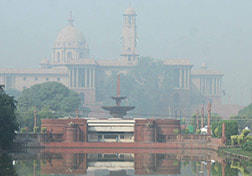
NEW DELHI - Even as medical practitioners sounded a caution against outdoor exercises as "there is no safe time to step outdoors", weather analysts see a slight improvement in Delhi's air quality for the next few days due to change in wind direction. According to weather forecast on Wednesday, the northwesterly winds which brought toxins from neighbouring Punjab and Haryana, due to stubble burning there, to Delhi have changed to...

southeasterly winds, thereby saving the national capital from extra emissions for the next two-three days. "Smog may drop in next two-three days due to this change in the wind direction, but dangerous trend would continue as these winds are not strong enough to disperse the high volume of pollutants already present in Delhi's air," Mahesh Palawat, Director, private weather forecasting agency Skymet, told IANS. On Wednesday, however, aided by unabated stubble burning in neighbouring states and a drop in mercury here, the air quality of Delhi-NCR had a further dip, with the Air Quality Index (AQI) of Delhi recorded at 355 on Wednesday against 351 on Tuesday.
Earlier in the day, medical practitioners in the national capital came up with a health advisory that suggested against outdoor exercises, saying "there is no safe time to be outdoors". According to the advisory, while the city with high volume of pollutants in the air is bad for exercising, running or participating in a marathon can add at least two tablespoonfuls of toxic ash to the lungs. The advisory pointed out that while a normal adult breathes approximately six litres of air per minute at rest, during exercising it increases to 20 liters. With the current level of air pollution in Delhi and NCR, this increases toxins in lungs.
"Exercise areas should be at least 200 meters away from roads, construction sites and smoke-emitting industry," advisory says, adding that "even this does not guarantee clean air".
On Wednesday, Delhi-NCR recorded hike in the PM2.5, or particles with diameter less than 2.5mm, ranging between 392 to 326 units, as compared to 362 to 302 units on Tuesday, according to the data from all ten monitoring stations of System of Air Quality and Weather Forecasting and Research (SAFAR). Safe limit for PM2.5 is 60 units as per national standards and 25 units as per international standards. According to the Central Pollution Control Board (CPCB), many places in Delhi recorded a "severe" AQI. Areas including R.K. Puram and Siri Fort in south Delhi, Delhi Technical University (DTU) in north Delhi, ITO in central Delhi, Anand Vihar in northeast Delhi and Punjabi Bagh in west Delhi, were places where AQI ranged from 400 to 440 considered "severe".
Vasundhra in Ghaziabad and Bhiwadi in Rajashtan (both NCR) also recorded "severe" AQI. With slight dip in past 24 hours, AQI for Ghaziabad was at 402 and for Bhiwadi 417, but still under "severe" category.
All other regions in Delhi and NCR recorded either "severe" or "very poor" air quality, with PM2.5 acting as the major pollutant.
Earlier in the day, medical practitioners in the national capital came up with a health advisory that suggested against outdoor exercises, saying "there is no safe time to be outdoors". According to the advisory, while the city with high volume of pollutants in the air is bad for exercising, running or participating in a marathon can add at least two tablespoonfuls of toxic ash to the lungs. The advisory pointed out that while a normal adult breathes approximately six litres of air per minute at rest, during exercising it increases to 20 liters. With the current level of air pollution in Delhi and NCR, this increases toxins in lungs.
"Exercise areas should be at least 200 meters away from roads, construction sites and smoke-emitting industry," advisory says, adding that "even this does not guarantee clean air".
On Wednesday, Delhi-NCR recorded hike in the PM2.5, or particles with diameter less than 2.5mm, ranging between 392 to 326 units, as compared to 362 to 302 units on Tuesday, according to the data from all ten monitoring stations of System of Air Quality and Weather Forecasting and Research (SAFAR). Safe limit for PM2.5 is 60 units as per national standards and 25 units as per international standards. According to the Central Pollution Control Board (CPCB), many places in Delhi recorded a "severe" AQI. Areas including R.K. Puram and Siri Fort in south Delhi, Delhi Technical University (DTU) in north Delhi, ITO in central Delhi, Anand Vihar in northeast Delhi and Punjabi Bagh in west Delhi, were places where AQI ranged from 400 to 440 considered "severe".
Vasundhra in Ghaziabad and Bhiwadi in Rajashtan (both NCR) also recorded "severe" AQI. With slight dip in past 24 hours, AQI for Ghaziabad was at 402 and for Bhiwadi 417, but still under "severe" category.
All other regions in Delhi and NCR recorded either "severe" or "very poor" air quality, with PM2.5 acting as the major pollutant.

 RSS Feed
RSS Feed
